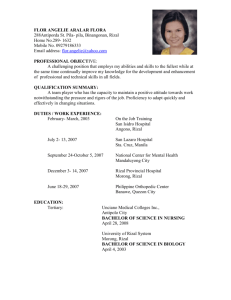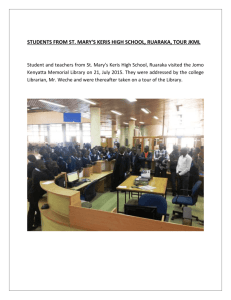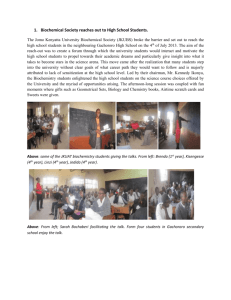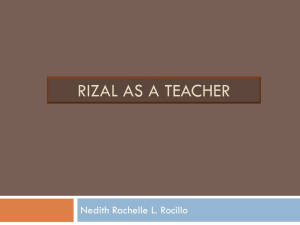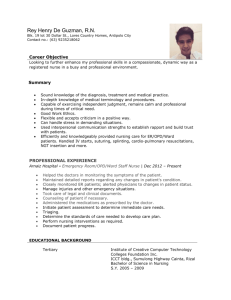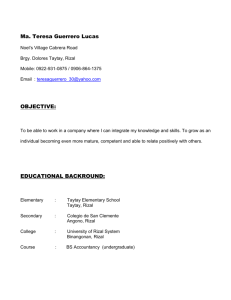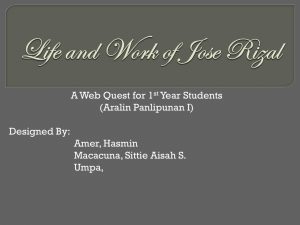Jose Protasio Rizal & Jomo Kenyatta Compared
advertisement
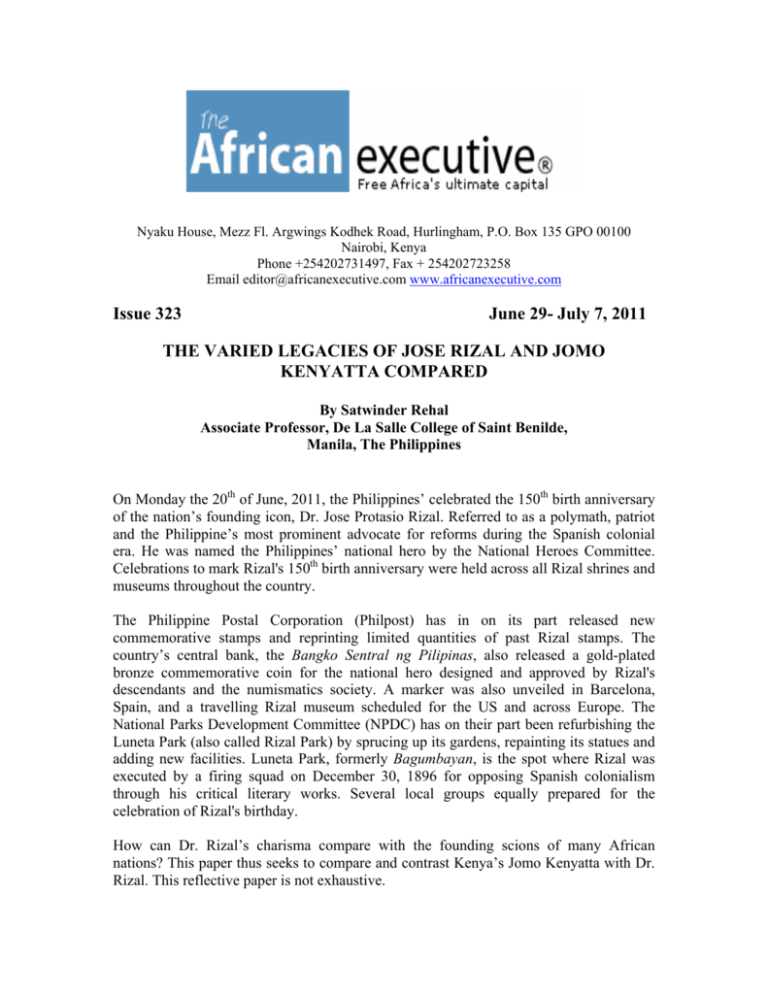
Nyaku House, Mezz Fl. Argwings Kodhek Road, Hurlingham, P.O. Box 135 GPO 00100 Nairobi, Kenya Phone +254202731497, Fax + 254202723258 Email editor@africanexecutive.com www.africanexecutive.com Issue 323 June 29- July 7, 2011 THE VARIED LEGACIES OF JOSE RIZAL AND JOMO KENYATTA COMPARED By Satwinder Rehal Associate Professor, De La Salle College of Saint Benilde, Manila, The Philippines On Monday the 20th of June, 2011, the Philippines’ celebrated the 150th birth anniversary of the nation’s founding icon, Dr. Jose Protasio Rizal. Referred to as a polymath, patriot and the Philippine’s most prominent advocate for reforms during the Spanish colonial era. He was named the Philippines’ national hero by the National Heroes Committee. Celebrations to mark Rizal's 150th birth anniversary were held across all Rizal shrines and museums throughout the country. The Philippine Postal Corporation (Philpost) has in on its part released new commemorative stamps and reprinting limited quantities of past Rizal stamps. The country’s central bank, the Bangko Sentral ng Pilipinas, also released a gold-plated bronze commemorative coin for the national hero designed and approved by Rizal's descendants and the numismatics society. A marker was also unveiled in Barcelona, Spain, and a travelling Rizal museum scheduled for the US and across Europe. The National Parks Development Committee (NPDC) has on their part been refurbishing the Luneta Park (also called Rizal Park) by sprucing up its gardens, repainting its statues and adding new facilities. Luneta Park, formerly Bagumbayan, is the spot where Rizal was executed by a firing squad on December 30, 1896 for opposing Spanish colonialism through his critical literary works. Several local groups equally prepared for the celebration of Rizal's birthday. How can Dr. Rizal’s charisma compare with the founding scions of many African nations? This paper thus seeks to compare and contrast Kenya’s Jomo Kenyatta with Dr. Rizal. This reflective paper is not exhaustive. Both individuals were born in relatively good families; born in the late 1890s, Jomo Kenyatta belonged to a respectable family where his father was the chief of a small agricultural village in Gatundu Division, Kiambu District; one of five administrative districts in the Central Highlands of the then British East Africa. After the death of his father, Jomo, was adopted by his uncle Ngengi, the latter who also took over the chiefdom. Born on June 19, 1861, in the town of Calamba, Laguna, Rizal was the seventh child in a family of 11 children and where his family was able to support his education by sending him to notable institutions in Manila such as the acclaimed Ateneo de Manila and the University of Santo Tomas. In their own ways, both individuals had envisioned the value of acquiring formal education; Dr. Rizal’s academic acumen was manifest from a tender age. For instance, in 1877, at the age of 16, he obtained his Bachelor of Arts degree from Ateneo de Manila. In the same year, he enrolled in Philosophy and Letters at the University of Santo Tomas while simultaneously taking courses leading to the degree of surveyor and expert assessor at Ateneo. He finished the latter course on March 21, 1877 and passed the Surveyor’s examination on May 21, 1878, but being of a minor age of 17, he was not granted a license to practice until December 30, 1881. In 1878, he enrolled in medicine at the University of Santo Tomas but had to stop his studies when he felt that the Filipino students were being discriminated upon by their Dominican tutors. On May 3, 1882, he sailed for Spain where he continued his studies at the Universidad Central de Madrid. On June 21, 1884, at the age of 23, he was conferred the degree of Licentiate in Medicine. Rizal continued his quest for the academe by studying further at the University of Paris and at the University of Heidelberg where he earned a second doctorate. In contrast, at the age of 10, Jomo was suffering from a jigger infection and was taken to the Church of Scotland mission hospital at Thogoto (about 12 miles north of the capital Nairobi), where surgery was successfully carried out on both feet and one leg. Jomo, then known as Kamau, was impressed by his first exposure to Europeans, and resolved to join the mission school. He ran away from home to become a resident pupil at the mission, studying amongst other subjects, the Bible, English, Mathematics, and carpentry. It is alleged that Jomo paid his school fees by working as a houseboy and cook for a nearby white settler. In 1912, having completed his mission school education, Jomo became an apprentice carpenter. In August of 1914 he was baptized at the Church of Scotland mission, initially taking the name John Peter Kamau, but later changing it to Johnson Kamau. His ambitions saw him depart mission for Nairobi to seek employment, starting out as an apprentice carpenter on a sisal farm in the neighbouring urban enclave of Thika. Avoiding recruitment into the British army as World War 1 progressed, Jomo relocated to the distant town of Narok, living amongst the Maasai community, where he worked as a clerk for an Indian contractor. It was around this time that he took to wearing a traditional beaded belt known in Kikuyu dialect as 'Kenyatta''. In 1922 Kamau adopted the name Jomo (a Kikuyu name meaning 'burning spear') Kenyatta, and began working for the Nairobi Municipal Council Public Works Department as a store clerk and water-meter reader. It was also the year that ushered in his political career inspired by the advocacy for Kikuyu land rights led by Harry Thuku’s East African Association (EAA). Indeed Jomo joined the EAA and its quest for land rights for the indigenous community. Indeed, both Rizal and Jomo were inspired by certain events towards academic success; the former’s decision to study medicine was inspired by the need to cure his mother’s blindness and the latter inspired by the surgery to his jigger infected feet and exposure to Europeans of the Church of Scotland missionaries in Thogoto. The involvement in politics by both individuals is uncannily similar. Four clear cut factors can be deduced in light of this. Firstly in their driving force that sought to highlight the atrocities of their respective colonial masters and seeking justice for their fellow countrymen; secondly in their non-violent means towards meeting this goal thirdly, in their foreign locations that acted as a springboard in their agitation for independence and justice, and fourthly, in the use of literature to express the atrocities of colonialism. In the hope of securing political and social reforms for his country and at the same time educate his countrymen, Rizal while in Europe, wrote several works with highly nationalistic and revolutionary tendencies. For example, in March 1887, his daring book, Noli me Tangere, a satirical novel exposing the arrogance and despotism of the Spanish clergy, was published in Berlin. In 1890 he reprinted in Paris, Morga’s Successos de las Islans Filipinas with his annotations to prove that the Filipinos had a civilization worthy to be proud of even long before the Spaniards set foot on Philippine soil. On September 18, 1891, his second novel, El Filibusterismo, printed in Ghent, Belgium, a sequel to Nolie Me Tangere, was described to be more revolutionary and tragic than the latter. Because of his fearless exposures of the injustices committed by the civil and clerical Spanish officials, Rizal provoked the animosity of those in power. On his part, the party Jomo had joined to usher in his political career was disbanded under governmental pressure, but its members came together again forming the Kikuyu Central Association (KCA). Jomo worked as editor of the KCA's journal between 1924 and 1929, becoming the party’s general secretary by 1928. In May of the same year, Jomo launched a monthly Kikuyu-language newspaper called Mwigwithania (Kikuyu for 'he who brings together') which was intended to draw all sections of the Kikuyu together. The paper, supported by an Indian owned printing press, had a mild and unassuming tone, and was thus tolerated by the British authorities. In February 1929 Jomo was dispatched to London to represent the KCA in discussions with the Colonial Office over fears that a planned settler government would be established by unionising the three colonies of Kenya, Uganda and the then Tanganyika; a move deemed detrimental to the indigenous locals. Refusal by the Secretary of State for the Colonies to meet him saw an undeterred Jomo writing several letters to various British newspapers, including The Times. The latter media house indeed published Jomo’s five point itemed letter in March 1930 that warned of dire consequences if the planned union was not revoked. In similar contrast, as a leader of a reform movement of Filipino students in Spain, Rizal used the media by contributing essays, allegories, poems and editorials to the Spanish newspaper, La Solidaridad in Barcelona though under a penname, Dimasalang. In May 1931 Kenyatta once again left Kenya for London, to represent the KCA, before a Parliamentary Commission on the 'Closer Union of East Africa'. Staying back, Jomo headed north to Birmingham and enrolled at one of the Selly Oaks colleges for a year. In August 1932 Kenyatta (who had by then joined the Communist Party) travelled to Moscow to study economics at the Moscow State University, under the sponsorship of Caribbean Pan-Africanist, George Padmore. His sojourn came to an end when Padmore fell out of favour with the Soviets. Rizal too toyed with revolutionary minds. For instance, in a humanitarian effort to help Cubans afflicted with yellow fever, Dr. Rizal intended as well to study Cuban revolutionary tactics based on learning from José Julián Martí Pérez. Marti’s writings and political activity had became a symbol for Cuba’s bid for independence against Spain in the 19th century and equally known for agitating against American expansion in Cuba. Indeed the two remained bosom buddies till the latter’s death in 1895. Returning to England in 1934, Jomo began his studies at University College, London, working on Arthur Ruffell Barlow's English-Kikuyu Dictionary. The following year he transferred to the London School of Economics, to study social anthropology under the renowned Polish anthropologist Bronislaw Malinowski. Malinowski significant influence on Jomo steering him in his thesis leading to the publishing of a revised version of his thesis as Facing Mount Kenya in 1938, a literally work that remains an important (and even classic) work for its insights into the traditions of Kikuyu culture. Effectively cut off in Britain from the KCA (which had by then been banned in Kenya) by World War II, Kenyatta continued to campaign for Kikuyu rights publishing several books and pamphlets, including a study of the Kikuyu language. Jomo returned to Kenya in September 1946 taking up the post of principal at the Kenya Teachers College in Githunguri. He was also invited to lead a newly formed political outfit, the Kenya African Union (KAU) becoming its president in 1947. Originally starting as a study union (Kenya African Study union), KAU sought to articulate indigenous grievances against the British colonial administration promptly demanding access to the settler occupied fertile lands then referred to as ‘White Highlights’. Just like Jomo, Rizal’s return to Manila saw him engage in active politics, more so by forming a civic movement, La Liga Filipina, advocating for moderate social reform through legal means. Though banned by the governor, Rizal’s outfit gave birth to the Katipunan led by radicals such as Andres Bonifacio and Emilio Aguinaldo. Unlike his contemporaries, Rizal advocated for freedom through non-violent revolution, advocating for freedom and self-government through peaceful means through the restoration of the people’s dignity. Like Rizal, Kenyatta distanced himself from the radicals in his party as well as the armed revolutionary guerrilla outfit called the Mau Mau. Despite this assertion, Jomo was implicated in the Mau Mau movement by the British authorities, and on 21 October 1952 he was arrested, tried and sentenced to seven-year hard labour for "managing the Mau Mau terrorist organization," termed as a proscribed society that had “conspired to murder all white residents of Kenya.” For his ‘crime,’ Jomo spent the next six years at Lokitaung before being moved to 'permanent restriction' in environmentally inhospitable location of Lodwar on 14 April 1959. On 21 August 1961 Jomo was finally released, on the condition that he didn't run for public office, in spite of the fact he was elected present of a newly formed political party, the Kenya African National Union, in absentia. By 1960 the British government conceded to the principle of one man-one vote for Kenya. In 1962 Kenyatta went to the Lancaster House Conference in London to negotiate the terms of Kenya's independence and in May 1963 KANU won the pre-independence election and formed a provisional government. When independence was achieved on 12 December in the same year, Kenyatta became prime minister. Exactly one year later, with the proclamation of a republic, Jomo Kenyatta became Kenya's first president. On the contrary, the same cannot be said of Rizal’s end game compared to Jomo’s. Accused of organizing a rebellion in July 1892, Rizal was exiled to Dapitan in remote Zamboaga del Norte. The revolution caused by an Andres Bonifacio led Katipunan in 1896 saw Rizal formally arrested while in exile for his association with the group and imprisoned in Fort Santiago, Manila. In jail, Rizal issued a manifesto disavowing the violent revolution, as Jomo did decades later when he dissociated with the armed insurgencies of the Mau Mau. In the manifesto, Rizal declared that the education of the Filipinos and their achievement of a national identity were prerequisites to freedom. Jomo on the other hand declared to achieve Kenya’s freedom through constitutional means. A sham trial convicted Rizal of the alleged charges and sentenced to death. Wallowing away in his prison cell, Rizal wrote an untitled poem, now known as "Ultimo Adios", considered a masterpiece and a living document expressing not only the hero’s great love of country but also that of all Filipinos. In contrast however, Jomo wrote a memoir of his tribulations while in detention titled Suffering Without Bitterness when he was already president of independent Kenya. At the age of 35 Rizal was executed on December 30, 1896 thereby making him a martyr of the Philippine Revolution. On the contrary, Jomo Kenyatta rose to the pinnacle of Kenya’s leadership and after 15 years in power, he passed away in his sleep from natural causes on 22nd of August 1978. Jomo Kenyatta’s vision was for a united Kenya, free from poverty, tribalism and discrimination. His legacy is etched quite literally in stone in form of the Nairobi's Jomo Kenyatta International Airport, the Kenyatta International Conference Centre, Kenyatta National Hospital, national schools, numerous main streets, two Universities and several other institutions. A statue in downtown Nairobi and several monuments all over Kenya stands tall in his honour. Similarly, Rizal’s legacy has seen a province dedicated to the national hero and named after him after a 1901 meeting that resolved to unify the then provinces of Manila and Morong into one named "Rizal". Various educational institutions are, similarly like Jomo, named after the hero in addition to educational scholarship programs. In opposite though, a fraternity organization, called the Order of the Knights of Rizal was signed into law by the President of the Philippines on June 14, 1951, becoming Republic Act 646. None such exists for Jomo Kenyatta. Dr. Rizal’s fascination with the sciences has seen three animal species names after him, said to have been discovered by Rizal himself while in exile in Dapitan namely a lizard classified Draco Rizali, a rare toad referred to as Rachophorous Rizali, and a beetle, Apogonia Rizali. As an anthropologist, Kenyatta’s legacy is unfortunately limited to his reformatted thesisFacing Mount Kenya. A number of celluloid films have been produced depicting Dr. Jose Rizal and where he has, with the present young generation, been turned into a fashion icon. Rizal is equally an internet sensation with a number of amateur animations portraying his heroism and speculating on how he would be in modern times. Dr. Rizal still remains a darling of artists, thespians and literature enthusiasts. Despite initial opposition, the Philippines passed a Bill on May 12, 1956 making compulsory reading of Rizal’s seminal works ‘Noli Me Tangere’ and ‘El Filibusterismo’ for collegiate students. More than a century later, it remains part of the college curriculum. The same cannot be said of Jomo Kenyatta. Among many Kenyans, especially the present generation of youth, he is limited to primary and high school class literature on Kenyan civic history and as an individual shrouded in mystic if not fear. Facing Mount Kenya remains an optional set text for students studying anthropology or sociology in local tertiary institutions, while his prison memoirs enshrined in Suffering Without Bitterness, unfortunately remains out of print. Creating a personality cult should not be the aim, especially in Kenya where ethnicity drives politics, but rather creating an overall awareness and academic orientation of nationalism and patriotism as depicted by many founding fathers, (e.g. India’s Mahatma Ghandi) especially in the age of globalization and diminishing identity with nation state among the young generation. This quest is in line with Dr. Rizal’s statement, "Ang kabataan ang pag-asa ng bayan" (The youth is the hope of our nation). The relevance of this statement is reflected by the Philippine’s National Historical Commission Chair who states that there is a quest to constantly remind the Filipino youth of Rizal's contributions. Can we say the same for the Kenyan youth? Jomo Kenyatta’s 15 year reign as president, though politically stable was mired with accusations of corruption and dictatorship. A question thus begs whether Dr. Rizal would have made a good president and if his legacy would have remained intact. Now, that we shall never know! ©2011 The African Executive
